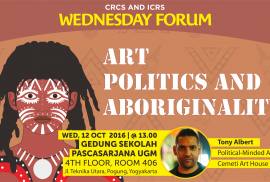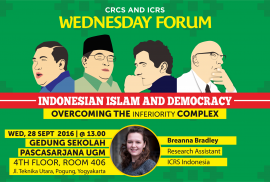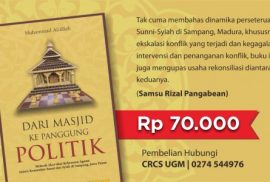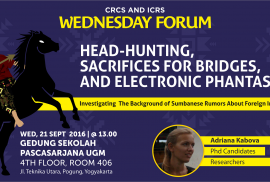Meta Ose Margaretha | CRCS | Thesis Review

In 2014, the President of Indonesia, Susilo Bambang Yudhoyono, released a policy addressing the “revitalization” including potential reclamation and economic development, of Benoa Bay at the southern tip of Bali. In the months that followed, there was public debate about the economic and environmental consequences of the proposal involving many sectors of Balinese and Indonesian society. Since Bali is well-known as the one majority-Hindu part of Indonesia, it was to be expected that religious identities and value also would have a significant role in the controversy. Daud Partigor’s thesis “Significances of Theological Argumentation in Rejecting the Proposed Reclamation of Benoa Bay” focuses of religious elements of the debate, including the role of religious institutions and of religious language and ideology as the legitimation for arguments opposing the reclamation of the bay. His research also shows that the debates on rejecting the proposed reclamation of Benoa Bay are part of a complicated process merging ideas of religiosity, the environment, economic interests, culture, politics and humanity in one pot. But, here also, the author tries to emphasize how religious ideas could be implemented at other levels, such as in governmental regulations to advocate the existence of Benoa Bay area.
In this case, the key theological element being promoted and argued is the concept of sacred places. Local people around the Benoa Bay consider the bay itself as a sacred space. Toward the sacred space, Balinese Hindus have their certain understanding that leads them to behave also in a certain way.
The discourse of Benoa Bay’s sacredness based on the teachings of Hindu-Bali traditions became public in early 2015. The ideas about the sacredness came from by analyzing how exclusively religiously-based arguments become explicitly used in the public discussion, the thesis offers insight into thethe revival of religion in public in a different context than Islam-focussed studies have offered.
The discourse of Benoa Bay as a sacred place is used by some organizations to advocate and protect Benoa bay from the reclamation. This study case is important because it shows how the policies made by both state and religion are influence each other. In the Bali context, the key actor is the Hindu Supreme Council or Parisada. Partigor explains how Parisada is divided between local branches and the central office in Jakarta which makes regulation and decisions for all the members of Parisada locally and nationally. In early 2016, the national board of Parisada issued a formal statement declaring the sacredness around the Benoa site and rejected the reclamation. Coming from the highest level of Hindu council in Indonesia, Parisada’s statement had political influences at the national level. that claim has a because it claimed to represent the whole Hindu community in Indonesia.
Parisada became the pioneer in reconstructed again the understanding of sacred place and other theological conceptions that used by other movements to reject the reclamation. Beginning of 2013, Parisada developed a theological argument about the reclamation of Benoa Bay based on principles found in Tri Hita Karana and Sad Kertih. The central text for the Hindu-Bali communities, Tri Hita Karana talks about living in perfect harmony the three elements of human life: God, then other human beings and the environment. Another theological conception that has been used by the Parisada to reject the reclamation, Sad Kertih also talks about living in harmony with the universe. Sad Kertih specifically mentions the ocean, the forests, the lakes and also other human. While the Tri Hita Karana coming from general Hindu concepts found in the Vedas, Sad Kertih draws on the tradition of local Hindu-Bali traditions. Veda They have been used previously to support other political interests, including supporting the 1969 Rencana Pembangunan Lima Tahun (five-year development plan).
Even though Hindus are the majority in Bali, especially in Benoa Bay area, Bali is not homogeneous. There are some other communities that aren’t Hindu. Therefore, according to the author, the claimed of sacredness in Benoa Bay should not be the ultimate reason to reject the reclamation but the society need their own logic and perspectives to perceive this problem.
There are some characteristics of religion revival in the case of Teluk Benoa Bay if we compare to Thoft’s characteristics of religion revival. First, it refer to the participation of religious communities, which is this case are represent by the Parisada and other religious communities that live around Benoa Bay. Second, crisis on understanding religion from the secular world. In Indonesia’s context this process happened after the fall of new order, while religion and state being separated and even there was intervention to the religious related things. The third characteristic is the freedom of religious expression which is also begin after the fall of new order. And the last one is the influence of globalization, democracy and modernization.
Partigor argues that the discourse using a theological perspectives in order to reject the proposed reclamation could be an evaluation of John Rawls’s theory about public logic. Rawls argued that any decision made in public should be based in inclusive ideas that canbe accepted by everyone from various backgrounds. In the debates of Benoa Bay reclamation, an exclusive idea was used in public by a religious actor and the public accepted it.
Title: Significances of Theological Argumentation in Rejecting the Proposed Reclamation of Benoa Bay | Author: Partigor Daud Sihombing (CRCS, 2016)
CRCS-UGM

Abstract
Tony Albert is a politically-minded artist provoked by stereotypical representations of Aboriginal people and the colonial history that attempts to define him, and what Aboriginality is, in the present. Interrogating contemporary legacies of colonialism that have impacted the lives of Aboriginal peoples in his homeland of Australia, he mines popular culture imagery and art historical source material while drawing upon personal and collective histories. His talk will explore Australian politics in relation to his own art practice. Examining the legacy of racial and cultural misrepresentation, particularly of Australia’s Aboriginal people, Albert has developed a universal language that seeks to rewrite historical mistruths and injustice.
Speaker
Tony Albert has spent the majority of his life in Brisbane, but has strong family connections further north to the Girramay and Kuku Yalanji people of the rainforest region of Australia. In 2004 he completed a degree in Visual Arts, majoring in Contemporary Australian Indigenous Art, at Griffith University. His work has been exhibited and collected by major institutions throughout Australia and he is currently artist-in- residence at Cemeti Art House, Yogyakarta.

Abstract
Indonesian Islam connotes a pluralistic form of faith that is open and deeply engages local-specific cultures that concurrently emphasize a rigorous pursuit of social justice and equality for all. Despite the voluminous scholarship on Indonesian Islam, its correlation with Muhammadiyah’s “Islam Berkemajuan” and Nahdhatul Ulama’s “Islam Nusantara”—each having its own vision for a good society—remains woefully unexplained. This paper explores the interplay between Indonesian Islam and the praxis of democracy within the historical context of overcoming an apparent inferiority complex suffered by some segments of the Muslim community. The authors argue that as much as Indonesian Islam may have proven itself to be distinct from ‘the other Islams’, commonly found in its birthplace in the Middle East, there is still much to be desired for in terms of how to confidently overcome the historical baggage as a once colonized people. Using Said and Foucault’s analytical frameworks, the paper argues for a less humble attitude toward the propagation of Indonesian Islam to the outside world, given the protracted period of instability in the Middle East, ongoing terror attacks in different parts of the world and the politics surrounding Islamophobia.
Speaker
Breanna Bradley is an undergraduate student at Georgetown University’s Edmund A. Walsh School of Foreign Service located in Washington, District of Columbia, USA. Bradley’s studies focus on the relationship between culture and politics in Southeast Asia. She is currently a research assistant at the Indonesian Consortium for Religious Studies (ICRS), a Ph.D. program in Inter-Religious Studies located at Universitas Gadjah Mada, Yogyakarta, Indonesia. She has previously held positions as an undergraduate research fellow at Georgetown University’s Berkley Center for Religion, Peace and World Affairs and as a program coordinator for Georgetown University’s D.C. School’s Project, a program aimed to provide English language access for the immigrant community of the Washington DC area. She is interested in the role that Indonesian Islam plays in Indonesian culture and politics and is currently assisting with research surrounding the Tabot festival, a festival with its roots in Shia Islam celebrated by a majority Sunni community every year in Bengkulu, Sumatra.
 Judul
Judul
Dari Masjid ke Panggung Politik, Melacak Akar-akar Kekerasan Agama Antara Komunitas Sunni dan Syiah di Sampang, Jawa Timur
Penulis
Muhammad Afdillah
Penerbit
CRCS 2016
ISBN
978-602-72686-6-1
Harga
Rp 70.000,-
Beberapa aspek politik dan kekerasan Sunni-Syiah di Sampang dibahas di dalam buku ini. Salah satu di antaranya penyebab konflik antara komunitas Sunni dan Syiah di Sampang. Selain itu, buku ini membahas dinamika konflik Sunni-Syiah, khususnya eskalasi konflik yang terjadi seiring dengan berjalannya waktu dan kegagalan intervensi dan penanganan terhadap konflik tersebut. Buku ini juga membahas usaha – usaha rekonsiliasi kedua komunitas, khususnya setelah kekerasan terbuka yang terjadi di Bulan Desember 2011 dan Agustus 2012.
(Samsu Rizal Panggabean, Pengajar di Magister Perdamaian dan Resolusi Konflik di Fakultas Ilmu Sosial dan Ilmu Politik, Universitas Gadjah Mada).
__________________________
Bagi yang tertarik, bisa menghubungi:
Divisi Marketing CRCS UGM
Gedung Lengkung Lantai 3
Sekolah Pascasarjana Universitas Gadjah Mada
Jl. Teknika Utara, Pogung, Yogyakarta, Indonesia 55281
Telephone/Fax : + 62-274-544976

Abstract
Rumors about head-hunting and construction sacrifices have been recorded in Southeast Asia since the beginning of 20th century. My focus is on the present-day form of these rumors on the island Sumba, Eastern Indonesia. First directed especially at the Dutch colonizers, stories about foreigners seeking for body parts have continually absorbed new features. In 1990’s, they focussed on new technologies that were imagined as electronic phantasms. Nowadays they target tourists and immigrants as well as people deviating from social norms. Following Jean-Nöel Kapferer, who defined rumors as one of the defense mechanisms by which members of communities try to preserve their old ways, I interpret Sumbanese rumors as a way for Sumbanese to define themselves in opposition to outside forces and as a tool for maintaining norms in society.
Speaker
Adriana Kábová earned her Master’s degree in Ethnology from the Charles University in Prague, Czech Republic. She is a PhD candidate in Anthropology, also at the Charles University in Prague, and is currently on an internship in the Pusat Studi Pariwisata at UGM. Her research interests include tourism and contemporary legends in Southeast Asia.
Daud Sihombing | CRCS | Article
 Wilfred C. Smith in his book “The Meaning and the End of Religion,” defines reification as mentally making religion into a thing, gradually coming to conceive of religion as an objective systematic entity. In this process, religions are standardized and institutionalized. For instance, there were no “Hindus” who defined their practice as Hinduism until the term Hindu was established by Muslims and later British colonizers who invaded and sought to know and rule India. It was Muslims and Westerners with their concepts of religion who constructed or reified Hinduism.
Wilfred C. Smith in his book “The Meaning and the End of Religion,” defines reification as mentally making religion into a thing, gradually coming to conceive of religion as an objective systematic entity. In this process, religions are standardized and institutionalized. For instance, there were no “Hindus” who defined their practice as Hinduism until the term Hindu was established by Muslims and later British colonizers who invaded and sought to know and rule India. It was Muslims and Westerners with their concepts of religion who constructed or reified Hinduism.
Based on Smith’s insight, I am going to conduct an art exhibition which I call REIFICATION. In this exhibition I create an imaginary government institution named the Department of Certification. In my exhibition, this fictional governmental institution issues certificates for beliefs that fulfill the requirements to be recognized as a religion. My goals by conducting this exhibition are framing the religious discourse I learned in the Center for Religious and Cross-cultural Studies (CRCS), Universitas Gadjah Mada, in a different medium and offering new perspectives for seeing religious life in Indonesia.
This project can be considered a reflection of the past or the prediction for the future. What I mean by the reflection of the past is that I am going to visualize the unseen practice of standardizing the concept of religion and recognizing particular religions that happen in the past, especially in Indonesia. In predicting the future, I argue that this governmental institution can exist in Indonesia when the Bill of Rights protecting all religious people has been finalized.
This method of manipulating, imitating, pretending, or camouflaging in order to document an alternate reality has been used effectively by both Indonesian and foreign artists. An Indonesian artist, Agan Harahap created a photo series entitled The Reminiscence Wall, a compilation of “fictional novels” based on history that combines various realities of what happened in the past. Another example is Robert Zhao Renhui, a Singaporean multi-disciplinary artist. He constructs and layers each of his subjects with narratives, interweaving the real and the fictional. He focuses on the relation between humans and the natural world. Both Agan and Robert Zhao creates new “facts”based on their own fictional narratives.
This exhibition will be held in:
LIR Space, Yogyakarta, from September 3rd to 17th, 2016.
Open 12 pm – 20 pm, Closed on Monday.
It will be curated by Mira Asriningtyas as part of the ongoing Exhibition Laboratory project organized by Lir Space.





